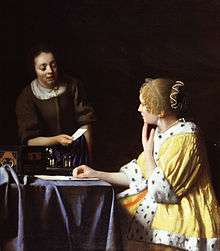Mistress and Maid

Mistress and Maid (c.1667) is a painting produced by Johannes Vermeer, now in the Frick Collection in New York City. The work of Johannes Vermeer, also known as Jan, is well known for many characteristics that are present in this painting. The use of yellow and blue, female models, and domestic scenes are all signatures of Vermeer. This oil on canvas portrays two women, a Mistress and her Maid, as they look over the Mistress' love letter.
Artist
Johannes Vermeer was born in 1632 in Delft, Holland.[1] He worked and lived in Delft all his life, although it is possible that he may have done an apprenticeship in another town such as Amsterdam or Utrecht for six years. A major stepping point in Vermeer's career was in 1653 when he joined the Guild of Saint Luke as a master and professional painter. Vermeer painted at a somewhat leisure pace, producing two to three paintings a year and there are 35 known to exist today. Vermeer's work shows that he was most likely a fan of the camera obscura, as parts are in focus as others slightly blur. There is also an intensity to his colors that supports the use of the obscura. Vermeer died at a relatively young age, 43, in 1675. He suffered most likely from a stroke or stress-induced heart attack. The slow rate at which he produced paintings restricted Vermeer from becoming wealthy during his lifetime, and he died in debt.[2]
Description
Mistress and Maid was painted over the years 1666–1667 on a canvas. The painting shows an elegant mistress and her maid as they look over a love letter that the mistress just received. There are prominent Vermeer styles presented in this painting. There is a strong use of yellow in the woman's elegant fur-lined overcoat, and blue in the silk tablecloth and the maid's apron. The focus of the painting is the two women as they are sitting at a desk, doing an everyday activity. Vermeer was known for his domestic scenes containing women. The light in the painting comes from the left, and falls on the mistress' face, as is apparent from the shadow of the table on her legs. This painting can seem very straightforward at first glance, but it has deeper psychological implications. If one looks at the image straightforwardly, one sees the mistress as she looks at the sealed love letter, hinting that she has a relationship with someone who is perhaps a great distance away. There is a hinted relationship between the maid and the mistress with their furtive glances and their body language, as they lean towards each other. The mistress has a pensive gaze, with her lips parted ever so slightly and her fingertips lifted to her chin in a questioning manner. The mistress' profile is slightly blurred and undefined and is meant to portray an idea that the woman is soft and sweet. This is likened to another one of Vermeer's paintings, Girl with a Pearl Earring. The painting is preserved well and it has stylistic features such as the large scale of the figures, the dark background, and the dramatic modeling within the scene. In Mistress and Maid, Vermeer played with his medium and created texture and light with his works. For example, the lighted parts of the yellow overcoat are formed with sweeping brushstrokes of lead-tin-yellow and the shadows are created with definition. Dark backgrounds were used in portraiture after Leonardo da Vinci created the trend. They were used because they gave focus to the person in the portrait and enhanced the three-dimensional effect. Vermeer uses dark backgrounds in his other portraits such as Portrait of a Young Woman and Girl with a Pearl Earring. There is a prominent usage of pearls on the mistress in this painting. Pearls were an important status symbol of the period and that was reflected in the mistress' fancy attire and her abundance of pearls. A prevalent theme in Vermeer's paintings from around the late 1660s is letter writings. In earlier works, there is one woman isolated with a letter, but in this painting the added maid is a new element. This gives the painting a sense of anxiousness between the two women over the letter and its potential contents.
See also
References
- ↑ "WebMuseum: Vermeer, Jan". Ibiblio.org. 2002-10-14. Retrieved 2013-06-29.
- ↑ "Girl With a Pearl Earring - The Story - Tracy Chevalier". Tchevalier.com. Retrieved 2013-06-29.
- About Vermmer." Tracy Chevalier. N.p., Dec. 2011. Web. 8 Mar. 2012.
- Janson, Jonathon. "Mistress and Maid." Essential Vermeer. N.p., 2011. Web. 8 Mar. 2012.
- Pioch, Nicolas. "Jan Vermeer." WebMuseum, Paris. N.p., 14 Oct. 2002. Web. 8 Mar. 2012
Further reading
| Wikimedia Commons has media related to Mistress and Maid (Vermeer). |
- Liedtke, Walter A. (2001). Vermeer and the Delft School. Metropolitan Museum of Art. ISBN 9780870999734.